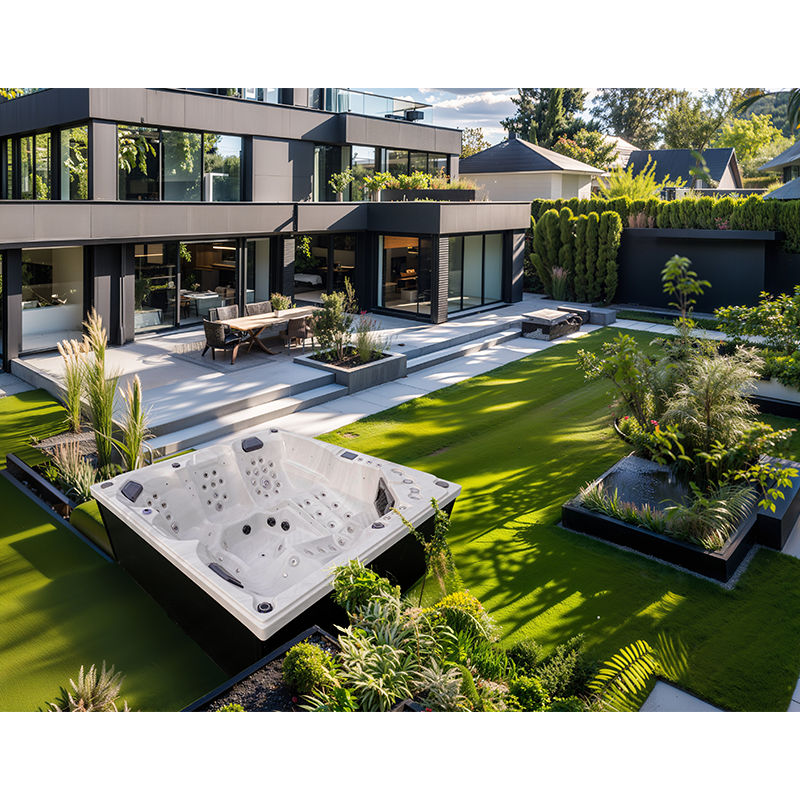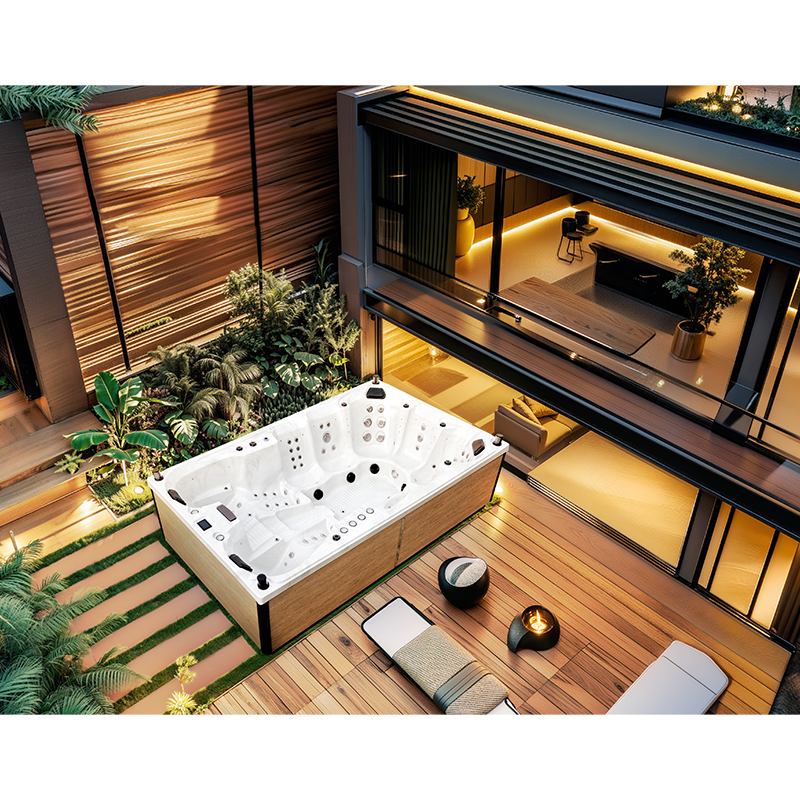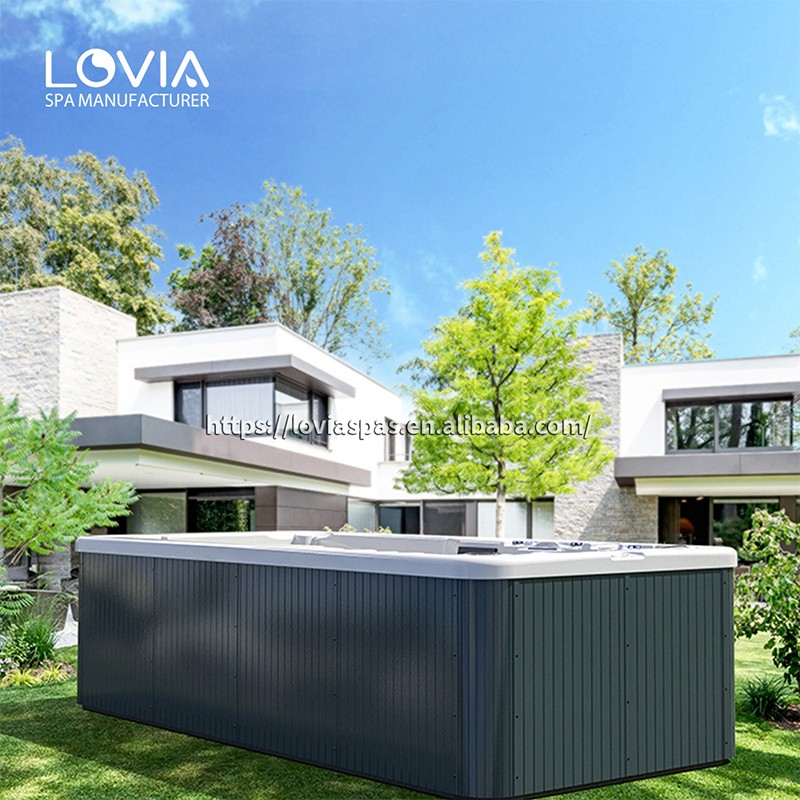
Which is better, a hot tub or a swim spa? What's the difference?
2024-09-17 15:30Hot tub and swim spa. While both offer spa and relaxation features, there are significant differences in design, functionality and experience.
So, which one is better, a hot tub or a swim spa? What's the difference between the two? This article will delve into this issue and help readers make an informed choice based on their needs.

Features, Advantages and Disadvantages of Hot Tubs
What are the characteristics of a hot tub?
A hot tub is an enclosed hydrotherapy device typically used in homes or small commercial establishments. Its main features include:
● Adjustable water temperature: The water temperature of a hot tub is usually between 37-40°C and can be adjusted according to user needs.
● Massage function: Equipped with a variety of massage nozzles, which provide full-body relaxation and therapeutic effects through water flow and bubble massage.
● Closed design: Usually a circular or square closed structure with a small size, suitable for home backyard or indoor installation.
What are the advantages of a hot tub?
● Relaxation and therapy: The high-temperature water and massage function of the hot tub help relax muscles, relieve stress and promote blood circulation, suitable for daily relaxation and recovery treatment.
● Easy to install: Hot tubs are small in size and light in weight, making installation relatively simple and requiring no complicated civil engineering work.
● Easy maintenance: Modern hot tubs are equipped with automatic filtration and disinfection systems, making daily maintenance simple and water quality easy to manage.
● Year-round use: Regardless of the season, hot tubs can provide a constant-temperature hydrotherapy experience and are suitable for year-round use.
What are the disadvantages of hot tubs?
● Limited swimming function: The hot tub is small in size and cannot be used for long-distance swimming. It is only suitable for short-term soaking and relaxation.
● Space limitations: Although hot tubs are small in size, finding a suitable installation location is still a challenge for some small households.
● Operating costs: Maintaining constant water temperature and quality requires a certain amount of energy, and long-term use may increase electricity bills.

Swim Spa Features, Advantages and Disadvantages
What are the characteristics of a swim spa?
Swimming spa pool is a large spa equipment that combines swimming and hydrotherapy functions. Its main features include:
● Versatility: Integrate swimming, massage and hydrotherapy, providing a variety of fitness and relaxation functions.
● Powerful water flow system: Through the powerful water flow system, users can conduct long-distance swimming training in a relatively small space.
● Open design: Usually a rectangular open structure with a large volume, suitable for installation in the backyard or indoor spacious space.
What are the advantages of a swim spa?
● Comprehensive fitness: The swimming spa pool not only provides a place for swimming training, but also has massage and hydrotherapy functions to meet the diverse needs of different users.
● Saving space: Compared with traditional swimming pools, swimming spa pools occupy a smaller area and are especially suitable for families with limited space.
● Convenient installation: The installation process of the swimming spa pool is relatively simple, no complicated civil engineering is required, and it can be installed on a flat ground.
● Year-round use: Equipped with a constant temperature system, it can be used in different seasons and climate conditions, providing a comfortable spa experience all year round.
What are the disadvantages of a swim spa?
● High initial costs: The initial purchase and installation costs of swimming spas are high, especially for high-end models, which are expensive.
● Operating costs: The operation of swimming spa pools consumes a lot of energy, especially heating and water quality management systems, and long-term use costs are high.
● Maintenance requirements: Although equipped with an automated system, regular inspection and maintenance are still required to ensure normal operation of the equipment and clean water quality.

What is the difference between a hot tub and a swim spa?
Differences in uses and functions
★ Hot tub: Mainly used for relaxation and therapy, it uses high-temperature water and massage functions to relieve muscle tension, promote blood circulation and reduce stress. Ideal for everyday home use, especially for users who wish to achieve the relaxing and healing effects of hydrotherapy.
✭ Swim Spa: Not only has the relaxing and therapeutic functions of a hot tub, but it also provides a place for swimming training. Ideal for users who want comprehensive water sports and fitness training at home.
Differences in installation and space requirements
★ Hot tub: small in size, light in weight and easy to install, suitable for backyards or small indoor spaces. For some small households, it is relatively easy to find a suitable installation location.
✭ Swimming spa pool: Large in size and covering a relatively large area, it is suitable for family backyards or spacious indoor spaces. For homes with limited space, installation location options may be limited.
Differences in cost and operating expenses
★ Hot tub: The initial purchase and installation costs are low, and the daily operation and maintenance costs are relatively small, making it suitable for users with limited budgets.
✭ Swimming spa pool: The initial purchase and installation costs are higher, and the daily operation and maintenance costs are higher. It is suitable for users with sufficient budget and high demand for comprehensive fitness.
Differences in health benefits
★ Hot tub: Through high-temperature water and massage function, it provides deep relaxation, pain relief and promotes blood circulation. Particularly suitable for users with muscle tension, arthritis or those in need of rehabilitation.
✭ Swimming hydrotherapy pool: Combining the comprehensive health benefits of swimming and hydrotherapy, it provides full-body aerobic exercise, enhanced cardiopulmonary function and improved physical fitness. At the same time, massage and hydrotherapy functions help relax the body and mind, relieve stress and improve sleep quality.

Conclusion
Hot tubs are suitable for daily relaxation and recuperation due to their relaxing and therapeutic functions, easy installation and low running costs; swim spas are suitable for those who want to have a comprehensive treatment at home due to their versatility, comprehensive fitness and year-round use. Water sports and fitness training users.
